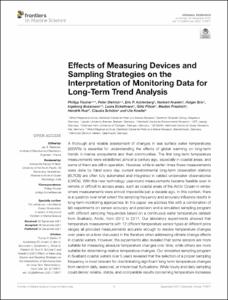| dc.contributor.author | Fischer, P. | |
| dc.contributor.author | Dietrich, P. | |
| dc.contributor.author | Achterberg, E.P. | |
| dc.contributor.author | Anselm, N. | |
| dc.contributor.author | Anselm, N. | |
| dc.contributor.author | Brix, H. | |
| dc.contributor.author | Bussmann, I. | |
| dc.contributor.author | Eickelmann, L. | |
| dc.contributor.author | Flöser, G. | |
| dc.contributor.author | Friedrich, M. | |
| dc.contributor.author | Rust, H. | |
| dc.contributor.author | Schütze, C. | |
| dc.contributor.author | Koedel, U. | |
| dc.coverage.spatial | Arctic Region | en_US |
| dc.coverage.spatial | Polar Region | en_US |
| dc.coverage.spatial | Kongsfjorden | en_US |
| dc.date.accessioned | 2022-03-31T21:04:30Z | |
| dc.date.available | 2022-03-31T21:04:30Z | |
| dc.date.issued | 2021 | |
| dc.identifier.citation | Fischer, P., Dietrich, P., Achterberg, E.P., et al (2021) Effects of Measuring
Devices and Sampling Strategies on the Interpretation of Monitoring Data for Long-Term Trend Analysis.
Frontiers in Marine Science, 8:77097, 18pp. DOI: https://doi.org/10.3389/fmars.2021.770977 | en_US |
| dc.identifier.uri | https://repository.oceanbestpractices.org/handle/11329/1909 | |
| dc.description.abstract | A thorough and reliable assessment of changes in sea surface water temperatures
(SSWTs) is essential for understanding the effects of global warming on long-term
trends in marine ecosystems and their communities. The first long-term temperature
measurements were established almost a century ago, especially in coastal areas, and
some of them are still in operation. However, while in earlier times these measurements
were done by hand every day, current environmental long-term observation stations
(ELTOS) are often fully automated and integrated in cabled underwater observatories
(UWOs). With this new technology, year-round measurements became feasible even in
remote or difficult to access areas, such as coastal areas of the Arctic Ocean in winter,
where measurements were almost impossible just a decade ago. In this context, there
is a question over what extent the sampling frequency and accuracy influence results in
long-term monitoring approaches. In this paper, we address this with a combination of
lab experiments on sensor accuracy and precision and a simulated sampling program
with different sampling frequencies based on a continuous water temperature dataset
from Svalbard, Arctic, from 2012 to 2017. Our laboratory experiments showed that
temperature measurements with 12 different temperature sensor types at different price
ranges all provided measurements accurate enough to resolve temperature changes
over years on a level discussed in the literature when addressing climate change effects
in coastal waters. However, the experiments also revealed that some sensors are more
suitable for measuring absolute temperature changes over time, while others are more
suitable for determining relative temperature changes. Our simulated sampling program
in Svalbard coastal waters over 5 years revealed that the selection of a proper sampling
frequency is most relevant for discriminating significant long-term temperature changes
from random daily, seasonal, or interannual fluctuations. While hourly and daily sampling
could deliver reliable, stable, and comparable results concerning temperature increases over time, weekly sampling was less able to reliably detect overall significant trends.
With even lower sampling frequencies (monthly sampling), no significant temperature
trend over time could be detected. Although the results were obtained for a specific
site, they are transferable to other aquatic research questions and non-polar regions. | en_US |
| dc.language.iso | en | en_US |
| dc.rights | Attribution 4.0 International | * |
| dc.rights.uri | http://creativecommons.org/licenses/by/4.0/ | * |
| dc.subject.other | Sensor selection | en_US |
| dc.subject.other | Sampling scheme | en_US |
| dc.subject.other | Environmental monitoring | en_US |
| dc.subject.other | Precision | en_US |
| dc.subject.other | Accuracy | en_US |
| dc.title | Effects of Measuring Devices and Sampling Strategies on the Interpretation of Monitoring Data for Long-Term Trend Analysis. | en_US |
| dc.type | Journal Contribution | en_US |
| dc.description.refereed | Refereed | en_US |
| dc.format.pagerange | 18pp. | en_US |
| dc.identifier.doi | https://doi.org/10.3389/fmars.2021.770977 | |
| dc.subject.parameterDiscipline | Water column temperature and salinity | en_US |
| dc.subject.dmProcesses | Data acquisition | en_US |
| dc.bibliographicCitation.title | Frontiers in Marine Science | en_US |
| dc.bibliographicCitation.volume | 8 | en_US |
| dc.bibliographicCitation.issue | Article 770977 | en_US |
| dc.description.sdg | 14.a | en_US |
| dc.description.eov | N/A | en_US |
| dc.description.adoption | National | en_US |
| dc.description.methodologyType | Reports with methodological relevance | en_US |
| obps.contact.contactname | Philipp Fischer | |
| obps.contact.contactemail | philipp.fischer@awi.de | |
| obps.resourceurl.publisher | https://www.frontiersin.org/articles/10.3389/fmars.2021.770977/ | |
 Repository of community practices in Ocean Research, Applications and Data/Information Management
Repository of community practices in Ocean Research, Applications and Data/Information Management

